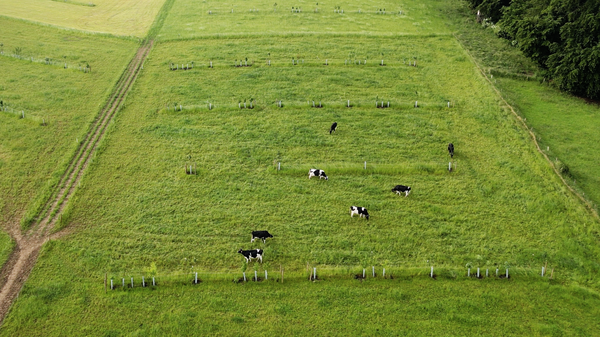Agroforestry Gladbacherhof
-
Agroforestry Gladbacherhof
Some of the most pressing questions in the future of agriculture include yield and yield stability, biodiversity, climate and water protection, as well as adaptation to climate change. Agroforestry systems offer promising solutions in this context by integrating fruit, timber, or biomass-yielding trees into agricultural land.
While much of the existing knowledge about agroforestry comes from tropical climates, we still need reliable insights for temperate zones. To help close this knowledge gap, we established three agroforestry systems between 2020 and 2023 at the Gladbacherhof, a teaching and research farm of the Justus Liebig University Giessen.
Discover more about our agroforestry systems, our research projects, and how these systems can contribute to sustainable agriculture in the future.
-
The three agroforestry systems
As part of the research project Agroforestry Systems Hesse I, we have developed three innovative agroforestry systems (GH1-3). All three systems are based on the principle of alley cropping, in which woody plants are combined with arable crops (silvoarabel) or grassland (silvopastoral). The systems offer numerous advantages and are particularly beneficial for:
Erosion control: Our silvoarable systems reduce the risk of erosion on agricultural land by having the tree strips run perpendicular to the slope direction.
Animal welfare: The silvopastoral system improves animal welfare by providing shade on the pasture.
Water retention and distribution: The GH3 silvoarable system was created in a so-called keyline design. The tree strips do not run straight in this system, but are adapted to the contours of the slope to ensure that rainwater is distributed over the largest possible area with a minimal incline.
All three agroforestry systems are designed for both practical use and research and serve as long-term experiments. The long-term and intensive investigation of the ecological benefits and economic indicators of all three agroforestry systems is the goal.
GH1 - Silvoarabel
Our first silvoarable agroforestry system on 3.5 hectares consists of six tree strips. Three of these represent the most widely used agroforestry system types in Germany: poplar, apple and timber. In between each of these are complex wood strips in which poplar, elder, apple and timber trees are combined according to the principles of successional agroforestry.
Learn moreGH2 - Silvopastoral
In the silvopastoral agroforestry system on 8 hectares, we compare pure apple tree rows with more complex tree rows in which apple trees are combined with value trees and in some cases also with pioneer trees. In addition, a fodder hedge was created. The shade provided by the trees and the fodder hedge should help to create an animal-friendly pasture for the dairy cattle.
Learn moreGH3 - Silvoarabel
Our third agroforestry system on 3.3 hectares is based on the keyline design. The water is to be distributed over the arable land, thus strengthening it for heavy rainfall and drought events. The tree strips include rows of apple trees and complex successional tree rows. In addition, the direct sowing of valuable trees is being tested and compared with the development of planted trees.
Learn more
-
Interactive Map Agroforerstry Gladbacherhof
-
Research projects
The foundation for our work was laid in 2020 with the research project Agrofrestry Systems Hesse I. During this phase, the three agroforestry systems were established, and the research infrastructure was developed. The follow-up project, Agroforestry Systems Hesse II, continues to expand this infrastructure while maintaining and managing the agroforestry systems. Currently, additional internal and external research projects are being initiated, which will allow for extensive knowledge gains from the three agroforestry systems...
Learn morePublications and reports
The agroforestry systems at the Gladbacherhof serve as long-term experiments to investigate the ecological effects and economic indicators of agroforestry systems. As part of the research projects Agroforestry Systems Hesse I and II, several publications and reports of various kinds have already been produced through cooperation with working groups at the University of Giessen and other institutes and project groups...
Learn more






